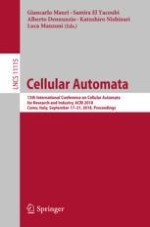
2018 | OriginalPaper | Chapter
Cellular Automata Model for Proteomics and Its Application in Cancer Immunotherapy
Authors : Soumyabrata Ghosh, Parimal Pal Chaudhuri
Published in: Cellular Automata
Publisher: Springer International Publishing
Activate our intelligent search to find suitable subject content or patents.
Select sections of text to find matching patents with Artificial Intelligence. powered by
Select sections of text to find additional relevant content using AI-assisted search. powered by